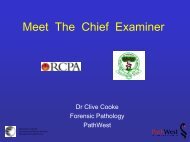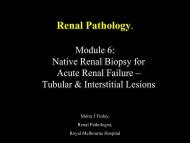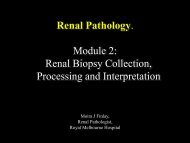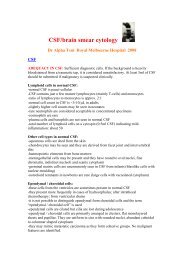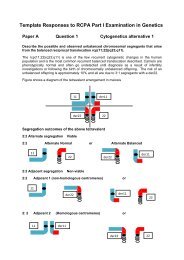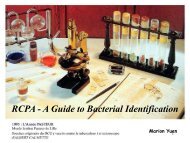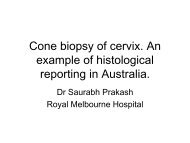Thyroid cytology - RCPA
Thyroid cytology - RCPA
Thyroid cytology - RCPA
Create successful ePaper yourself
Turn your PDF publications into a flip-book with our unique Google optimized e-Paper software.
The diagnosis of follicular carcinoma is not made on <strong>cytology</strong>. The<br />
diagnosis is made histologically in the presence of transcapsular and/or vascular<br />
invasion. The term “follicular neoplasm” is used in <strong>cytology</strong> to include adenoma /<br />
carcinoma.<br />
Hurthle cell neoplasm:<br />
-same as follicular neoplasm except the majority of the cells are Hurthle cells<br />
-forms clusters, microfollicles and single cells with scant colloid<br />
-rare cases may show papillae<br />
-some cells may have intranuclear grooves and pseudoinclusions<br />
-cells with prominent nucleoli favour Hurthle cells, as compared to small nucleoli in<br />
cells from papillary carcinoma with squamoid cytoplasm<br />
Papillary carcinoma:<br />
-cellular<br />
-little or no colloid in the background (colloid may appear as dense, globular, bubble<br />
gum-like – uncommon feature)<br />
-cells arranged in papillary, monolayer tissue fragments, clusters or dispersed as<br />
single cells<br />
-well-formed papillary clusters that appear as 3-D finger-like (smears do not always<br />
contain papillae)<br />
-most frequently seen architectural feature: sheets of cohesive cells, focally with<br />
nuclear crowding and overlapping and in parts with a distinct well defined<br />
“anatomical” edge of a row of cuboidal or columnar cells (due to flattening of papillae<br />
when the sample is smeared)<br />
-cells have a polygonal contour with well-defined margins and a central nucleus<br />
-cytoplasm generally abundant, sometimes dense and homogeneous or granular with<br />
well-defined cytoplasmic borders (may look squamoid or metaplastic)<br />
-cells may contain numerous vacuoles or show clear-cell change<br />
-nuclei are oval or angled (arrow-head shape) and moderately enlarged<br />
-chromatin is finely granular, delicate, 'powdery', hypochromatic and the nucleolus is<br />
small<br />
-optically clear “Orphan Annie” nuclei are not seen (fixation artifact) on routine Pap<br />
stain<br />
-however, nuclear clearing has been described in Ultrafast Papanicolaou-stained<br />
smears<br />
-nuclear pseudoinclusions and longitudinal folds are often noted (the more cells that<br />
are involved, the more specific is the diagnosis)<br />
-nuclear pseudoinclusions are more specific than grooves for papillary carcinoma<br />
-more than 20% of the cells with grooves are virually diagnostic for papillary<br />
carcinoma. Less than 10% of the cells with nuclear grooves virtually excludes a<br />
diagnosis of papillary carcinoma.<br />
-multinucleated giant cells are found up to 50% of cases (some believe this is<br />
relatively specific; giant cells may be seen in Hashimoto’s thyroiditis and nodular<br />
hyperplasia)<br />
-psammoma bodies (only with typical concentric lamination counts) are seen




